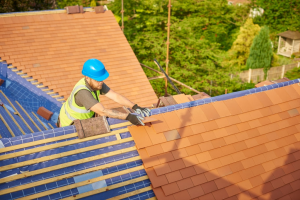Flat roofing is the most common roofing type preferred by most of homeowners these days. People love the flexibility of flat roof designs.
Though the name indicates when you choose to construct a flat roof, you get a horizontal surface, however, unlike their name, these roofs are not flat, but they do have a very slight roof pitch. A bit of negligence in constructing that slop leads to problems that are beyond repair.
If you are planning to install flat roofing in your home, you must gather enough information about different types of flat roofing materials and styles beforehand.
Because of the choices are not made right and your flat roof is not constructed properly, it might get leaks which are beyond repair.
We have compiled this guide for those who have no idea about the different types of materials available in the market.
Once you have decided that you want to install flat roofing in your home, this guide is for you. To understand different types of flat roofing, give this article a detailed read.

Types of Flat Roofing
Single Ply Membrane Roof
Installing a membrane is the latest roofing trend these days and it is the preferred choice of various commercial businesses.
Technically, these types are known as elastomeric or plastomeric roofs depending upon the type of membrane being used.
Single-ply roofs are the best choice of both residential and commercial customers. Neoprene, EPDM, PVC & Chlorinated polyethylene are some of the most common single-ply membrane roofs installed these days.
Of all these membranes, mostly flat roof contractors advise their clients to install EPDM rubber roof as these are flexible, and can easily handle temperature changes. You can hire a flat roofing company to complete the work within time.
Bitumen Roll Roofs
If you are looking for a long-lasting roof, Bitumen roofing is the best option for you. It works effectively for both hot and cold temperatures.
It actually is a type of asphalt that most roofing companies recommend as a modern alternative to the built-up roof.
If you choose to install a bitumen roof in your home, you will not have to worry about its maintenance for about 20 years or more.
It is their longevity and proven track record that this type of roofing is in extensive use these days.
Built-Up Roofing
It would not be wrong to call it the grandfather of built-up roofing because the trend of built-up roofing started around 120 years back. When you install a built roofing system in your home, there remains no issue of low pitch roof.
While designing built-up roofing, your flat roofing contractor uses several layers of bitumen surfaces. These days ply sheets are mostly used for built-up roofing.
Then, a fiberglass mat is used for reinforcement. If you are living in a warmer climate, installing built-up roofing is entirely a good idea. It can last for more than 30 years in hot climates.
EPDM Rubber Roof
This is another common choice of installers. The best thing about EPDM rubber roofing is that it is reusable. No matter, if you fix the surface mechanically or just lay it loosely, you can easily remove it and reuse it at some other place.
It is both the high durability and strong waterproof protection that people prefer using this type of flat roofing in their homes. If you want to get more protection for your home against UV lights, consider installing an EPDM rubber roof in your home.
This material is known for its greater durability. With proper care, you would notice that it can last for more than 50 years.
Spray Polyurethane Foam Roof
In this of flat roofing, your contractor begins with high-density polyurethane foam. This foam is sprayed from a wand or sprayer and for better results; it is then again coated with a material that is waterproof.
When you choose to install this kind of roofing in your home, you get a seamless roofing system in your home in which you have no joints, seams or cracks.
Because of its great water resistance, this kind of roof prevents your roof from issues like moisture, heat, and, cold. You don’t need to worry about roof leakage in the rainy season.
Bottom Line!
No matter what type of flat roofing, you choose to install, you can easily get the design and cost of your choice. You can also go for popcorn sealing to avoid any issue with the roof. Now, you are able to distinguish between different types of flat roofing. I hope this article will help you out in choosing the right roof for your home.

